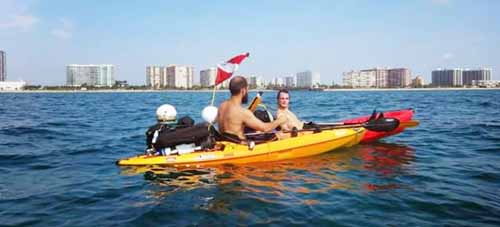|
|
Dayo Scuba's Guide to Kayak Diving
Kayak diving...A new way to scuba dive!

Kayak diving opens up a new range of dive sites in both the ocean and springs of Florida. It gives scuba divers independence from dive boat operators, while allowing access to dive sites which are too far away to comfortably swim to. Divers enjoy dive sites that are less visited, and getting closer to many animals that are easily scared off by a motor. You don't have the headache and associated costs with motorized boats. It's also a more environmentally friendly, greener way to dive!

Other advantages include more social time during the dive trip, more economical costs, divers have somewhere to rest comfortably during dives and benefit from an upper body workout that scuba diving doesn't provide.
Checklist for Kayak Divers:
For the Kayak:
Paddle, Seat, Sponge (or other bailer), Drain Plug, PFD, Bow Line, Bungee-Cords, Dive Flag, Signal/Distress Whistle
For the Diver:
Full set of scuba gear, appropriate exposure protection, watch, compass, dive flag, Visual Distress Signal/SMB
Other goodies (depending on length of trip):
Dry Bag, lunch/snacks, First-Aid Kit, Save-A-Dive Kit, towel, water bottle, sun screen, hat, sunglasses, rinse water

A note on PFD Requirements:
A wearable PFD (personal flotation device/life preserver) is required aboard all sea-going vessels. Some kayak divers think their craft is unsinkable, and that a PFD is unnecessary. Most kayak divers normally wear a has a full wetsuit and have a BCD onboard too that they think are sufficient for water emergencies.
However, few dive kayaks are virtually unsinkable, and kayaks can easily get away from their operators in the surf. A padded vest can help prevent injuries in a wipe-out.
A note on Dive Flags:
Dive flags are required by law in Florida; divers are required to conduct their diving activities within 100 feet of the flag, and vessels are required maintain a certain distance from the flags, depending on the location of the activity.

It would be nice to believe that the average boater would realize there were divers in the area when they come upon anchored and vacant kayaks flying dive flags out on the water, and act accordingly. Unfortunately they reality is that some boaters do not make this connection, and cause serious injurious to divers.
This being said, your dive flag is your only hope for letting them know what you are up to when all other clues just don't click!
Tips for a stress free kayak dive:
* Kayak diving is not (meant to be) strenuous, but it is more demanding than scuba diving from a commercial boat or shore. Make sure you are well rested, and a fairly confident paddler, before you embark on a kayak dive trip.
* Practice pulling your scuba gear up on the kayak in water too deep to stand in before you venture on your trip!
* Put your (fully assembled) scuba gear up between your legs for the journey out. This will trim the kayak out better. For wave riding (on the way back in), if they gear is on the back-end, it will lighten the front end for better wave riding.
* Do not leave go of any gear that does not float until it is properly secured.
* Stay close to or on the beach until you are ready to pull your kayak out quickly, jump on, and start paddling out through surf. If you are going to be hit by a wave, it is even more important that you keep paddling as hard as you can right up until the wave hits you.
* Use your upper body, in addition to your arms, for paddling. Remember to push forward on the dry end as well as pulling on the blade in the water.
* Get in the habit of checking (and resetting if necessary) your anchor at the start of your dive, and releasing it (or placing for easy release) as you finish your dive.
* Use plenty of anchor line, especially for fast current, high winds and swell.

|
|
|